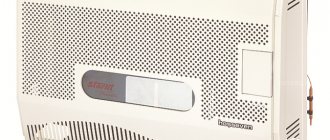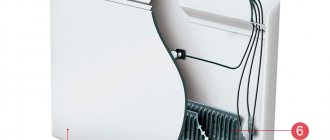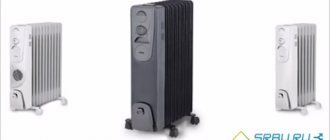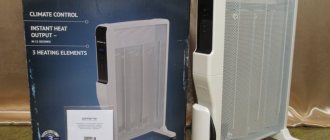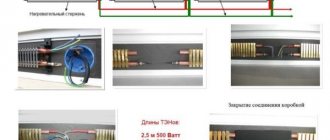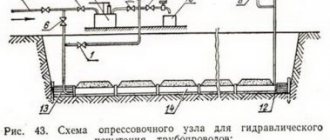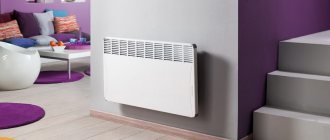What are they?
The working diagram of a heater with a fan looks something like this. Inside the equipment there is a fan, the blades of which drive cold air to hot heating elements - spirals. It blows through the spirals, heats up and rushes into the room, raising the air temperature in it.
Stationary models do their job better. They heat the room more evenly due to the fact that they have a rotating mechanism.
The advantage of the device is that it is able to quickly create a favorable temperature in the room. In summer, such devices can be used as a fan, allowing you to save the family budget. You pay for one device, but get two at once: a heater and a fan.
Infrared heating systems
These types of electric heaters contain special lamps inside the housing. These lamps are capable of emitting long-wave infrared rays, invisible to the human eye. From them, like from the sun (by analogy with nature), all objects in the room (floors, walls, furniture) heat up, and then the air. According to their design, these heaters are:
- Ceiling.
- Wall-mounted.
- Floor-standing.
They can be installed not only in living rooms, but also, if necessary, on balconies, terraces, greenhouses, etc.
Advantages of infrared heaters:
- Quiet operation.
- Economical energy consumption.
- The ability to heat without raising dust into the air.
- The devices do not dry out the air and do not burn oxygen.
- Uniform heating of the air throughout the entire room (for more details on the operating scheme, see the article on the operating principle of a heater with infrared radiation).
- When you turn on the device, the room begins to warm up instantly.
The disadvantages of these devices include their rather high cost.
Types of heating elements
All heaters equipped with a fan differ in the type of heating element. There are three of them in total:
- spiral;
- tubular;
- ceramic.
We will look at each type in more detail so that you can form your own opinion.
Spiral
In most models, the spirals are made of nichrome. This installation consists of a ceramic base wrapped with thin wire. You can find devices enclosed in a glass tank, but with an open heating element.
Devices in which the wire is not protected are very dangerous. After all, the spiral can heat up to 1000 degrees in a matter of minutes, and if the equipment overturns on the floor, there is a risk of fire.
Another disadvantage of a heater with an open spiral is the unpleasant odor. It occurs due to the fact that dust settling on the surface of the nichrome wire begins to smolder after turning on the device.
Oil radiators
Oil heaters, which are fairly mobile batteries filled inside with mineral oil, are very good for heating a private house or apartment. The surface of the battery is heated by heating the oil using heating elements (1 or 2 heating elements are connected). Such radiators consist of several sections, and the more of them, the more heat such a battery gives off.
When choosing an oil home heater, pay attention to its power. The required power is calculated as follows: 1 kW can heat a room of 10 m2 (with a ceiling height of up to 3 m).
Also, oil heaters sometimes have built-in fan heaters, which greatly reduces the time it takes to warm up the room. The advantages of oil heating devices include:
- The presence of a thermostat that can be used to regulate the power of the device (if there are two heating elements, then there should also be two thermostat knobs).
- Equipped with a timer (in most modern models) to set the time to turn the unit on or off.
- Relatively low cost.
- Mobility (they can be freely moved around the room or to other rooms).
- The ability to work for some time without consuming electricity (due to already heated oil, which cools very slowly), which can provide significant savings.
Types of fans in a heating device
Fan heaters also differ in the type of fans they are equipped with:
- plastic (they are included with small devices);
- metal (in large appliances).
There are two types of fans:
- Axial. They are equipped with small mobile devices. Its blades have a standard design. True, the operation of heaters equipped with axial fans cannot be called silent.
- Tangential. It is an oblong cone equipped with about 30 blades installed parallel to each other. Devices with tangential fans are characterized by high performance and silent operation. But since the length of the cone cannot be called small, only stationary electric heaters - columns - are equipped with this design.
Heater design
Fan heaters are also classified according to their method of execution. So, in stores you can find two types of devices:
- Mobile. Equipped with an axial fan. They have low power - up to 2 kW. The undoubted advantage of mobile devices is the ability to move to any part of the room, small size and weight.
- Stationary. The power of the devices is from 1.8 to 2.6 kW. They are equipped with a tangential fan, which in column-type heaters is installed vertically. The performance of the devices is significantly higher. Quite often, such units are equipped with an automatic turning mechanism. Stationary electric heaters are used in shops, cafes, restaurants, often at entrances - as a thermal curtain so that they cut off the cold street air.
Control system
Fan heaters also differ in their control method. Happens:
- Mechanical control, which is most often equipped with mobile devices with an axial fan.
- Electronic – heaters of this type are much more expensive than mechanical ones.
Modern models are often equipped with a control panel, which is undoubtedly very convenient.
How to choose a good fan heater
When going to the store to make a purchase, check out some of the characteristics of fan heaters to choose a good and durable option.
When choosing a device, pay attention to the following points:
- Power.
- Type of heating element.
- Operating mode.
- Rotating base.
- Fan type. Of course, the best is tangential.
- Availability of automatic shutdown sensors. In case of overheating or tipping over, the device will turn off on its own.
- Thermostat.
- The housing is protected from moisture and splashes.
- The presence of a humidifying filter. Positively affects human health.
- Remote Control. Adds ease of use.
What is the name of a heater that blows warm air?
A household heater is a device that is used to heat rooms. Heaters come in different types, but all of them are used in homes, offices and apartments mainly in the form of additional heating. They are most in demand in the autumn, when the central heating pipes are still cold, but the rooms are already cool. But not every heating device is able to cope with the task, because the room can be large, and the air temperature can be quite low. In addition, not every unit is economical.
Therefore, in order to find out which heating device is right for you and can fully solve your problems, you should find out its functionality and technical characteristics. When you go to the store to make a purchase, sometimes you can even get confused, because they differ in size, appearance, design, technical capabilities and other parameters. Some heaters also have additional features that can be incredibly useful.
Kinds
Oil heaters
Such devices externally resemble cast iron batteries.
The advantages of such units include:
- The heating temperature in most cases is less than 60 degrees, as a result of which there will be no unpleasant burning smell. Oxygen is not burned.
- Such units are capable of working for several days without stopping, nothing will happen to it.
- Fire safety.
- Silent operation of the unit.
The disadvantages of oil radiators include:
- Slow heat release.
- Significant costs for electrical energy.
Fan heaters and heat guns
These units have a simple design. They use a heating element that heats the air, as well as a fan that circulates the heated air masses. Thanks to this design, the fan heater quickly heats the room, distributing warm air masses.
The advantages of such units include:
- Small dimensions and weight.
- Fast distribution of heat in the room.
- Low cost.
- Economical.
The disadvantages of fan heaters include:
- High noise level, which can irritate pets and household members.
- They burn oxygen and also pollute the air.
Fan heaters are suitable for small spaces. They can also be of three types:
- Spiral. The main element here is the heating coil.
- Ceramic. Here the main element is ceramic plates. They are safer, but also more expensive.
- Tubular. Here the main element is the tube, which is made of stainless steel. Inside it is a graphite rod or wire. A device with similar elements ensures gradual heating and high safety.
Convector household heater
These are one of the most powerful and compact heating devices. They are used in residential and industrial premises. These devices are very effective. Most of these heaters have timers that allow you to control the temperature of the air masses and the time period of operation. There are models that have increased insulation, so they can be used even in rooms with high humidity.
The advantages of such devices include:
- Safety
- Simplicity and ease of use.
- Silence.
- Durability.
The disadvantages of convector devices include:
- High price.
- Long time to heat the room.
Infrared heaters
The main element of such a unit is an infrared heater, which is sealed in a quartz tube. It is he who emits heat waves that come into contact with the surface of bodies and release their energy. As a result, these bodies begin to heat the air masses that surround them.
The advantages of such devices include:
- High security.
- Safety.
- Small dimensions.
- Ease of use.
- Relatively low energy consumption.
The disadvantages of infrared devices include:
- High price.
- Low mobility.
- Limited application.
In terms of design, infrared devices can be:
- Floor-standing.
- Ceiling.
- Wall-mounted.
A regular electric fireplace can also be a type of heater.
Device
Oil heaters have the following main elements:
- A metal reservoir in which the thermal fluid is located. In most cases this is mineral oil.
- A heating element that heats the oil.
- Unit body.
- Thermostat and control panel required to regulate temperature.
The fan heater has the following design:
- Housing made of heat-resistant and impact-resistant plastic.
- A heating element, which can be made in the form of a metal spiral, heating element or ceramic plate.
- Built-in fan.
- Control Panel.
The main elements of infrared heaters are:
- Heating element-emitter.
- A reflector made of aluminum or polished steel.
- Heat-resistant metal case.
- Fire hazard sensor.
- Thermostat.
Operating principle
A household heater has a principle of operation depending on its design. So a standard household fan heater works like this:
- To start working, you need to turn the knob on the control panel.
- The heating element and the fan are turned on, which moves the air masses.
- The degree of heating of the heating element is controlled using a separate regulator, which is located on the control panel.
The principle of operation infrared heater is similar to the operation of the sun. The device generates heat rays, they are absorbed by household elements, walls, ceilings. These surfaces heat up, warming the room. The result is exactly the same effect created by the sun.
A convector household heater operates on the principle of convection. Air, depending on the current temperature at different altitudes, has different densities. Due to this, cold air forces lighter, warmer air masses to move.
A heat exchanger is located at the bottom of the unit; air flow is directed to it through the corresponding slots in the housing. There are holes at the top through which heated air masses exit. They point upward, sending cold air downward. Cold air is sucked into the convector, the cycle repeats again.
Application
A household heater of the appropriate type is used in appropriate domestic premises. Thus, fan heaters are often used for local heating of small rooms and spaces. Convectors are used as simple, efficient and economical electrical appliances, which are used during cold periods for additional heating of rooms. Such units are often found in apartments and houses, including offices and studies.
Infrared devices are often used in homes, health and medical institutions, including production. They are also successfully used in outdoor conditions, for example, for heating summerhouses, balconies, verandas of summer cafes, sheds, and so on.
How to choose a household heater
- A heater should be purchased wisely. Therefore, before purchasing, you should decide where and how it will work. For home conditions, one type of heater is best suited, for a large house or outdoor garage - a completely different one.
- It is necessary to pay attention to the power of the heater. This will determine how much area and how long it will be able to heat. It should be noted that per square meter for an unheated room there should be about 0.1 kW of power. When purchasing a device for additional heating of a room in a house or apartment with an area of 20 square meters, a power of up to 1 kW is sufficient. If there is an external wall or two windows, 0.2 kW per square meter of area will be required. There are special programs that help calculate the power of the unit for a specific room.
- To quickly heat a room, a fan heater is best. An oil heater with a fan is also appropriate. If safety is important to you, then it is important to purchase a household heater with a thermostat. Such a unit will maintain the required temperature even when there are no people in the room. However, it must be taken into account that such a unit will burn oxygen and make noise. If you are not ready for this, then it is better to take a closer look at other devices.
- Convector heaters are perfect for heating a small room. With a built-in thermostat, you can set a comfortable temperature.
- To heat a specific surface, it is best to turn your attention to an infrared household heater. The device is easy to use and is also well suited for small spaces. However, it should be borne in mind that such infrared devices cause unusual sensations: the apartment will initially be cool, but the body will be warm, as if it were under a little sun.
A household heater is a device that is used to heat rooms. Heaters come in different types, but all of them are used in homes, offices and apartments mainly in the form of additional heating. They are most in demand in the autumn, when the central heating pipes are still cold, but the rooms are already cool. But not every heating device is able to cope with the task, because the room can be large, and the air temperature can be quite low. In addition, not every unit is economical.
Therefore, in order to find out which heating device is right for you and can fully solve your problems, you should find out its functionality and technical characteristics. When you go to the store to make a purchase, sometimes you can even get confused, because they differ in size, appearance, design, technical capabilities and other parameters. Some heaters also have additional features that can be incredibly useful.
Kinds
Oil heaters
Such devices externally resemble cast iron batteries.
The advantages of such units include:
- The heating temperature in most cases is less than 60 degrees, as a result of which there will be no unpleasant burning smell. Oxygen is not burned.
- Such units are capable of working for several days without stopping, nothing will happen to it.
- Fire safety.
- Silent operation of the unit.
The disadvantages of oil radiators include:
- Slow heat release.
- Significant costs for electrical energy.
Fan heaters and heat guns
These units have a simple design. They use a heating element that heats the air, as well as a fan that circulates the heated air masses. Thanks to this design, the fan heater quickly heats the room, distributing warm air masses.
The advantages of such units include:
- Small dimensions and weight.
- Fast distribution of heat in the room.
- Low cost.
- Economical.
The disadvantages of fan heaters include:
- High noise level, which can irritate pets and household members.
- They burn oxygen and also pollute the air.
Fan heaters are suitable for small spaces. They can also be of three types:
- Spiral. The main element here is the heating coil.
- Ceramic. Here the main element is ceramic plates. They are safer, but also more expensive.
- Tubular. Here the main element is the tube, which is made of stainless steel. Inside it is a graphite rod or wire. A device with similar elements ensures gradual heating and high safety.
Convector household heater
These are one of the most powerful and compact heating devices. They are used in residential and industrial premises. These devices are very effective. Most of these heaters have timers that allow you to control the temperature of the air masses and the time period of operation. There are models that have increased insulation, so they can be used even in rooms with high humidity.
The advantages of such devices include:
- Safety
- Simplicity and ease of use.
- Silence.
- Durability.
The disadvantages of convector devices include:
- High price.
- Long time to heat the room.
Infrared heaters
The main element of such a unit is an infrared heater, which is sealed in a quartz tube. It is he who emits heat waves that come into contact with the surface of bodies and release their energy. As a result, these bodies begin to heat the air masses that surround them.
The advantages of such devices include:
- High security.
- Safety.
- Small dimensions.
- Ease of use.
- Relatively low energy consumption.
The disadvantages of infrared devices include:
- High price.
- Low mobility.
- Limited application.
In terms of design, infrared devices can be:
- Floor-standing.
- Ceiling.
- Wall-mounted.
A regular electric fireplace can also be a type of heater.
Device
Oil heaters have the following main elements:
- A metal reservoir in which the thermal fluid is located. In most cases this is mineral oil.
- A heating element that heats the oil.
- Unit body.
- Thermostat and control panel required to regulate temperature.
The fan heater has the following design:
- Housing made of heat-resistant and impact-resistant plastic.
- A heating element, which can be made in the form of a metal spiral, heating element or ceramic plate.
- Built-in fan.
- Control Panel.
The main elements of infrared heaters are:
- Heating element-emitter.
- A reflector made of aluminum or polished steel.
- Heat-resistant metal case.
- Fire hazard sensor.
- Thermostat.
Operating principle
A household heater has a principle of operation depending on its design. So a standard household fan heater works like this:
- To start working, you need to turn the knob on the control panel.
- The heating element and the fan are turned on, which moves the air masses.
- The degree of heating of the heating element is controlled using a separate regulator, which is located on the control panel.
The principle of operation infrared heater is similar to the operation of the sun. The device generates heat rays, they are absorbed by household elements, walls, ceilings. These surfaces heat up, warming the room. The result is exactly the same effect created by the sun.
A convector household heater operates on the principle of convection. Air, depending on the current temperature at different altitudes, has different densities. Due to this, cold air forces lighter, warmer air masses to move.
A heat exchanger is located at the bottom of the unit; air flow is directed to it through the corresponding slots in the housing. There are holes at the top through which heated air masses exit. They point upward, sending cold air downward. Cold air is sucked into the convector, the cycle repeats again.
Application
A household heater of the appropriate type is used in appropriate domestic premises. Thus, fan heaters are often used for local heating of small rooms and spaces. Convectors are used as simple, efficient and economical electrical appliances, which are used during cold periods for additional heating of rooms. Such units are often found in apartments and houses, including offices and studies.
Infrared devices are often used in homes, health and medical institutions, including production. They are also successfully used in outdoor conditions, for example, for heating summerhouses, balconies, verandas of summer cafes, sheds, and so on.
How to choose a household heater
- A heater should be purchased wisely. Therefore, before purchasing, you should decide where and how it will work. For home conditions, one type of heater is best suited, for a large house or outdoor garage - a completely different one.
- It is necessary to pay attention to the power of the heater. This will determine how much area and how long it will be able to heat. It should be noted that per square meter for an unheated room there should be about 0.1 kW of power. When purchasing a device for additional heating of a room in a house or apartment with an area of 20 square meters, a power of up to 1 kW is sufficient. If there is an external wall or two windows, 0.2 kW per square meter of area will be required. There are special programs that help calculate the power of the unit for a specific room.
- To quickly heat a room, a fan heater is best. An oil heater with a fan is also appropriate. If safety is important to you, then it is important to purchase a household heater with a thermostat. Such a unit will maintain the required temperature even when there are no people in the room. However, it must be taken into account that such a unit will burn oxygen and make noise. If you are not ready for this, then it is better to take a closer look at other devices.
- Convector heaters are perfect for heating a small room. With a built-in thermostat, you can set a comfortable temperature.
- To heat a specific surface, it is best to turn your attention to an infrared household heater. The device is easy to use and is also well suited for small spaces. However, it should be borne in mind that such infrared devices cause unusual sensations: the apartment will initially be cool, but the body will be warm, as if it were under a little sun.
Are you shivering from the cold in the office, but at home you wrap yourself in a warm blanket and never part with a mug of tea? You need a heater, which has long become an indispensable thing for countries where winter lasts more than 4 months. How to prevent yourself from freezing and choose the best heater?
Why buy a heater?
The “hottest” (in the figurative sense of the word) time, which forms the main demand for the purchase of heaters, is late autumn, when heating has not yet arrived in residential buildings, and the cold has approached the apartments closely. However, if we take into account the work of Russian utilities and climatic conditions, a heater in an apartment can be useful at almost any time of the year. Modern heaters are high-tech, safe devices that can not only heat a room, but also, if they have some functions, humidify the air and even cool it.
What types of heaters are there?
Today, stores offer a wide variety of different heaters and heating systems. Moreover, the devices differ from each other not only in the manufacturer, but also in their design.
Oil filled radiator
One of the most common types of devices in everyday life. According to the principle of its operation, it resembles a conventional central heating battery. The oil cooler is a sealed metal housing filled with mineral oil. It, heated by an electric coil, transfers heat to the metal, which, in turn, heats the room.
An oil radiator consists of several sections (usually from 5 to 15), the number of which directly affects the heat exchange area. The more sections, the less the device heats up, and the less chance of getting a burn when touching it. Oil radiators do not produce noise, do not burn oxygen, are fireproof and have a relatively low price for all their advantages. They can be safely left on overnight. Despite its heavy weight (about 10 kg), the oil radiator remains quite mobile, since it is usually equipped with wheels. However, this type of device takes a long time to warm up to operating temperature - 10-20 minutes.
Test of heaters of famous brands
How to choose heater power?
Having chosen the type of heater you like, you need to pay close attention to its power. To do this, you need to decide which room the device will heat. A medium-power device can warm up a small living room. In a large room it will work hard. This means that optimally selected power will increase the service life of the heater.
There are many tables to calculate the required power in each individual case, but in reality everything depends not so much on the volume of the room, but on its heat loss. It will be difficult to heat even a small room if it is constantly blowing from the window and the walls are cold, since the room is corner.
Just keep in mind that for the average living space up to 10 sq.m. A heater with a power of 1.5 kW (1 kW) is enough . Here and below, the required power for auxiliary heating is indicated in parentheses, while the main power value, which is in front of the brackets, is suitable in the event of a complete shutdown of central heating in the fall and in light frosts. A room with an area of up to 15-20 sq.m. It is better to heat with a model with a power of 2 kW (1.5 kW) , and a room of 25-30 sq.m. do not warm up with a heater weaker than 2.5 kW (2 kW)
Advantages
- Ability to maintain a set temperature for a long time
- Don't burn oxygen
- Relatively low power consumption after reaching operating mode
Flaws
- Large dimensions and only floor placement
- Slow heating of the room
Fan heater
The most budget-friendly type of device, which enjoys stable popularity among consumers. The design of this heater is simple: a heating element is installed in its body, behind or in front of which a fan is located. Working together, they form a stream of hot air that spreads throughout the room.
As a rule, fan heaters are compact, mobile and quickly heat the air. Fan heaters almost always create a noticeable level of noise; the heating element burns oxygen or, at a minimum, greatly dries out the air in the room. Moreover, models with a ceramic heater are compared to budget “breeches” with a wire heater in terms of energy consumption and efficiency. differ very little.
Advantages
- Compactness
- Fast air heating
- Low price (compared to oil and, especially, convection heaters of comparable power)
Flaws
- Burns oxygen or dries out the air greatly
- Constant noise during operation
Convector
According to the principle of its operation, it is similar to fan heaters, with one significant difference: in convectors, air enters the heating element naturally, avoiding “overclocking” by the fan. In this type of device, a metal pipe or module with an additional radiator acts as a heating element. The air, passing through this element, heats up and, becoming lighter, rushes upward, and a “cold front” comes in its place.
In this case, the hot flow enters the room vertically, so it is distributed evenly. This type of device “reaches” its operating temperatures quite quickly - in 40-70 seconds. Convectors are usually hung on the wall, combining them into a single heating system for the room. They do not produce noise, as a rule, do not burn oxygen and are fireproof. Moreover, many devices of this type allow you to set a certain temperature and maintain it with relatively high accuracy. .
Advantages
- High room heating rate
- Uniform heating of the room
- Quiet operation
Flaws
- Budget models have an “oxygen burning” effect
- Specialists are required to organize a heating system
- High price
Infrared heaters
A lamp generating infrared rays is used as a heater. These devices do not heat the air, but the objects around them, and they, in turn, transfer heat to everything else. Infrared heaters have the function of zonal or spot heating, the principle of which is to heat an object, and not the entire room.
IR models are economical and silent, so many users consider them almost perfect heating devices. Typically, these devices have a sealed housing, so they can be used outdoors and in bathrooms. Using such a heater prevents the appearance of fungus on tiles and walls.
However, debate about the health hazards of such heaters continues. In addition, if the IR model is located not very far from a person’s workplace or bed, the effect of dryness and baking of the skin may be felt. In rare cases, you may even get a burn if you fall asleep under a powerful IR heater. In addition, IR models do not evoke the usual sensations for a person: the room is cold, and the body seems to be basking in a little sun. Moreover, the heat is only on the side that is oriented towards the heater. A tourist warming himself by the fire experiences approximately the same sensations. Therefore, we will not recommend IR heaters to everyone. Of course, with the right choice and proper installation, the IR model will be very effective, but if you make a mistake, being in this room can turn into hard labor.
Advantages
- Silent operation
- Fast, targeted heating
- Possibility of outdoor use
Flaws
- High price
- Some models emit irritating light
- Inability to heat a large room
- Not always pleasant physiological sensations from the operation of an IR heater
- The debate over health safety has not stopped.
Thermal curtains
Although this type of heater is designed to create an optimal temperature near doors, gates or windows, they can easily heat a small room. Typically, this directional fan is installed on the side or top of the doorway, blowing warm air over the entire area.
The “heat shield” does not let cold air from outside into the room and protects against drafts. Prevents heat loss by 70–90%. According to the principle of operation, the thermal curtain is completely identical to the fan heater (adjusted for the form factor of the device), but, as a rule, it produces even more noise. Therefore, it is not recommended for residential use.

